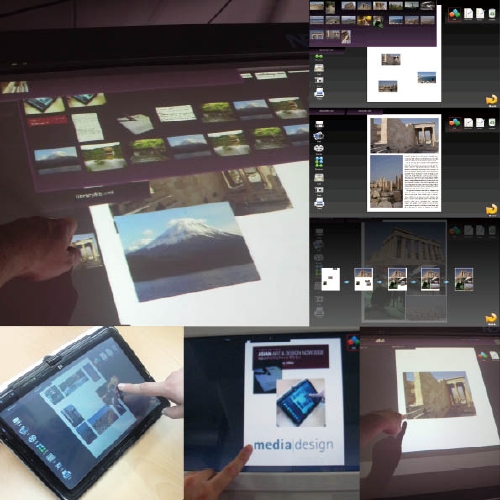Exhibitor's Profile
Editorial and Collaboration System "The ComDesign System"
Perez Pealez Mariano + Toshiya Fujii + Wonsuk Nam
With the development of the information and network technologies the computer has become a tool essential for remote communication and collaboration. Different methods has been explored for performing this task, mainly centered in the simple interchange of video / audio, images or files and not fully use all the support the current computers can provide. In the other side, documents are present in our every day live and are frequently used for collaboration and discussion. Using the document creation approach, we propose a new system for remote collaboration in which the computer takes a more active role, not being only simple interchange of the data between the remote terminals.

Documents are presents in our every day live. Every individual, in different situations must to create different style of documents, from a club activity poster to business period results. So we can say everybody is familiar with documents. Also in most cases this documents are created by working in groups; people get together to create documents that then distribute to others. Therefore, we think that the document creation is a good environment for long distant communication.
One of the targets of our system is enhance the communication between distant users. This i s made by improving the information exchange, making smaller the gap from a remote user to other. The system also is efficient for detecting users that not participate actively in the process. The interaction is very simple, manipulating directly the elements in a virtual desktop. The design aids are materialized in the form of design services, a set of tools that let the user visualize information and speed up or automate the document design or facilitate communication. The automated design services create a new design following different systems using grid layout. Other services provide information, as for example balance of the document. The user controls which services are active / inactive so it can be easy adapted to different work conditions.
All the tools needed are fully integrated in the system, including the document creation, resource management and document publication. All the actions made inside the system are watched and stored. Then this data is also fully stored when the document is saved. So the documents inside the system are not only the final version, but also the added value of the information of how was made. The system includes a document process player in which any document creation steps are visualized as a video. It is possible to change certain elements before continue or to start redesigning in any moment of the reproduction.
One of the problems of other advanced systems is that they require an specific hardware. This hardware is usually very expensive or even in some case only available as prototypes. Our system makes use of advanced interfaces, but also remains compatible with more usual hardware. The system has a customized user interface manager that allows the system to work using a standard mouse and keyboard, a single touch Tablet PC or a multi-touch screen. Also has a scalar and portable architecture, in order to run in slow machines or limited mobile devices.


ペレス・ペラエス・マリアーノ Perez Pelaez Mariano
1979 年 スペイン生まれ。
アニメーション制作会社にプログラマーとして勤務の後、来日。ユーザーインタフェースの研究に携わる。国際情報通信研究科博士課程在籍
 HOME
HOME